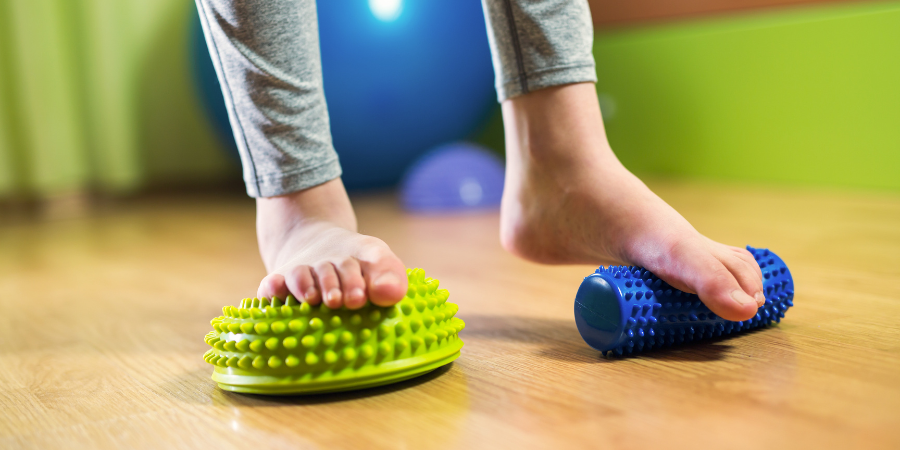



September 16, 2024
Flat feet, or a drop in the arches of the foot, is a problem that many children struggle with. Although it is a natural stage of foot development in the first years of life, it is worth knowing when and how to intervene to prevent future problems. Below are some practical tips to help parents ensure the healthy development of their child's feet.
1. Understand the natural development of your feet
- Natural process: All children are born with flat feet, which is caused by a thick fat pad. It is not until around age 4 that the feet begin to take on a more pronounced shape and the longitudinal arch begins to form.
- Key Age: Around the age of 5, special attention should be paid to foot development. The first signs of arches forming should be visible at this time. If you don't notice any changes by then, it's worth consulting a physiotherapist.
2. Recognizing the symptoms of flat feet
- Pay attention to your child's gait: If you notice your child walking on their toes, with excessive outward rotation of the foot, or with a clear weight on the heels, this may be a sign that something is wrong. An unusual gait may indicate problems with the feet, which can transfer to other joints - knees, hips, and even the spine.
- Diagnosis: If in doubt, it is worth doing a podoscopy test or consulting a physiotherapist. A test on a special pedobarographic mat will allow you to assess the load on your feet both at rest and during movement.
3. When to intervene?
- Assessment of the degree of flat feet: If the diagnosis shows that the child has significant deviations from the norm in the shape of the feet, it is necessary to take action. Intervention may include corrective exercises and in some cases the use of orthopedic inserts.
- Manual therapy: For more advanced flat feet, your physical therapist may recommend three-dimensional manual foot therapy, which helps improve bone alignment and strengthen the muscles responsible for proper foot function.
4. Exercises for children with flat feet
- Daily Exercises: One simple and effective exercise is toe walking. Encourage your child to tiptoe during daily activities, such as brushing their teeth.
- Consistency: It is important that the exercises are performed regularly. Single sessions once a week will not bring the expected results. Exercises must become part of the child's daily routine.
5. Choosing the right footwear
- Proper shoes: It is essential that the shoes are half a size too big, which will allow the foot to expand naturally when walking. It is important that the heel is well supported and the forefoot has enough room.
- Avoid hard soles: Hard soles can restrict the natural movement of the foot and cause orthopedic problems. Choose shoes with flexible but stable soles.
6. Physical activity as prevention
- Movement is key: Encourage your child to be physically active, which strengthens the muscles in their feet. Cycling, running, football – any form of exercise that engages the feet will be beneficial.
- Walking barefoot: Walking barefoot on various surfaces, especially sand or grass, helps to naturally strengthen the foot muscles and improve their function.
7. Monitoring and next steps
- Regular check-ups: Even if flat feet don't seem to be a problem, it's still a good idea to regularly monitor your child's foot development. A visit to a specialist once a year will allow for early detection of any problems.
- Orthopedic consultation: For more serious problems, especially when flat feet are associated with other postural defects, orthopedic consultation may be necessary.
Flat feet in children is a problem that, if detected early and treated properly, does not have to lead to serious complications. The key is early diagnosis, regular exercise and proper selection of footwear. Remember that healthy feet are the foundation of your child's health for the future. Take care of them today!
Another edition of the Health Policy Program for the Prevention of Tick-Borne Diseases (Lyme disease), implemented between 2023 and 2025 for residents of Wrocław County, is coming to an end. This initiative was made possible thanks to the involvement of Wrocław County and the financial support of the Lower Silesian Voivodeship Government. The program, implemented by the NZOZ Twój Lekarz (Your Doctor Public Healthcare Facility), generated significant interest, with over 500 people participating. Its main goal was to increase health awareness…
Who we are
In our work, we are guided by the idea of a family doctor who provides the patient with comprehensive care at all times, not only when they are ill. Our mission is to take care of the health of residents on a daily basis. We provide health education and promote prevention.
Copyright © Wrocław 2021 NZOZ Your Doctor Sp. z o. o. All Rights Reserved.
Website created by KomuKoncept: www.komukoncept.pl






